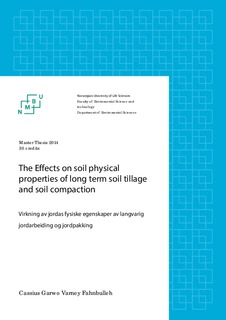| dc.description.abstract | Soil degradation in crop production is becoming increasingly important because of the growing
concern it poses on soil functions. Prominent among the degradation factors is soil compaction. It
impairs soil productivity by impeding the soil conductivity potential and moisture retention ability,
thereby preventing root penetrability and nutrients uptake among other things. This paper is
concerned with identifying and characterizing the degree of compaction that may result in
deleterious effects on soil physical properties, and the interaction that exists between crop growth
and productivity. The above shall be achieved through field and laboratory determination of soil
measurements from samples collected on a silty clay loam, and a silty loam soil at the University
of Life Sciences (UMB / NMBU) experiment field
Three land preparation practices (Autumn ploughing at 20 – 22 cm depth; Spring ploughing at 12
– 15 cm depth and Spring harrowing at 4 -6 cm depth i.e. without ploughing), stubble cultivation
and compaction were the treatments used in a three factorial field trials on a silty clay loam and a
silty loam soil to conduct the investigation at the UMB / NMBU experiment field. The three main
grain crops produced for the last 20 years were: wheat (Triticum aestivum L.), oats (Avena sativa
L.) and barley (Hordeum vulgare L.). Field data collection and standard laboratory procedures
were performed using different equipments and gadgets to process the data. These were calculated
and statistically analyzed by the ANOVA methods (GLM procedure), (SAS Institute, 1990).
The various treatments did not show much diversity in densification save few tillage applications
with stubble cultivation, compaction, and a combined tillage and compaction treatments that were
significant S* (i.e. Pr > F) than the others as shown in Tables 2, 4, 8 and 9 in results. Tillage in
depths 5-10 cm and 15 – 20 cm showed significant penetration resistant (PR) (Pr > F), and stubble
cultivation in depths 10 – 15 cm and 25 – 30 cm also gave significant PR (Pr > F). Fraction 6 – 20
mm exhibited significant aggregate size distribution with tillage application (Pr > F) in Tab.4.
Volume % was significant (Pr > F) with compaction application for pF 4.2 in depth 25 - 30 cm,
while weight % was equally significant for pF 4.2 in the same depth with the same treatment. The
same trend occurred for both pF 4.2 weight % and volume % for combined tillage times compaction application in the same depths. There was minimal
difference in dry matter (DM) % between treatments, as well as water content in grain yield at
harvest. However, both grain yield and dry matter % showed significant level (Pr > F) with tillage
treatment, but only grain yield gave significant level with compaction treatment.
The maximum bulk density (BD) observed in this trial was 1.60 g / cm³, which is just slightly
above the minimum critical limit of 1.55 g / cm³ that may restrict root penetration. In this case,
any hindrance to root piercing may eminate from the presence of clay minerals, ions bonding and
particle density. This implies that a minimum level of compaction resulted from the treatments. | nb_NO |
